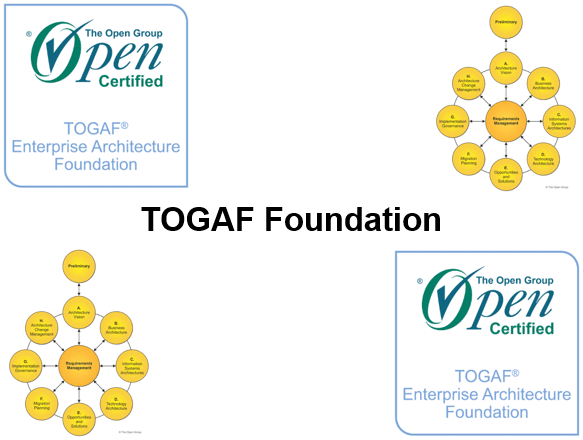-
Learning by doing
-
Trainers with practical experience
-
Classroom training
-
Detailed course material
-
Clear content description
-
Tailormade content possible
-
Training that proceeds
-
Small groups
In the course TOGAF Foundation, participants learn to use the TOGAF Framework when designing an Enterprise Architecture and to apply TOGAF concepts in projects. Participants are also prepared for the TOGAF Foundation certification exam.
The TOGAF course begins with an introduction to Enterprise Architecture and the role TOGAF plays within it. Participants will explore the benefits of adopting TOGAF in organizations and get familiar with its structure, including the Architecture Development Method (ADM), content framework, and governance models. Reference models and TOGAF certification opportunities are also discussed.
Next, participants dive into TOGAF's core concepts, including the four architecture domains: business, data, application, and technology. The module explores deliverables, artifacts, and building blocks. Additionally, it covers the TOGAF content metamodel, stakeholder management, business scenarios, and risk analysis.
The Architecture Development Method (ADM) forms the backbone of TOGAF. This module provides an overview of the ADM phases and the architecture development cycle. Participants learn how to define architecture principles, shape architecture vision, and adapt the ADM to specific needs. Architecture governance and process management are also included.
This module focuses on the various reference models used within TOGAF, such as the Technical Reference Model and the Infrastructure Reference Model. It also covers architecture maturity models, microservices architecture, and digital business frameworks. Participants will explore how to apply reference models and build roadmaps, as well as understand the roles and skills required of architects.
Here, participants explore the individual ADM phases in detail. Topics include business architecture, capability mapping, operational models, business process modeling, and the development of information system architectures. Data modeling, application portfolio management, IT technology trends, and security considerations are also covered, along with migration planning.
In this module, participants learn about the TOGAF Capability Framework and how it supports effective Enterprise Architecture implementation. Key topics include governance principles, change management, the role of the architecture board, architecture contracts, compliance frameworks, risk assessment, transition planning, and continuous improvement techniques.
Finally, the course wraps up with focused preparation for the TOGAF Foundation exam. This includes an overview of the exam format, sample questions, practical exercises, and proven strategies for time management and answering effectively. The module concludes with a Q&A session to address any remaining questions.
The course TOGAF Foundation is intended for Enterprise, IT and Solution Architects and Business Analysts who are involved in the Enterprise Architecture of a company.
No TOGAF knowledge is required to participate in the course. Basic knowledge of IT and business strategy is certainly useful.
Explanation using presentations and case studies are followed by practical exercises. Sample questions from the TOGAF Foundation exam are also discussed.
After successfully completing the course, participants will receive a certificate of participation in TOGAF Foundation.

Module 1: Intro to TOGAF |
Module 2: TOGAF Core Concepts |
Module 3: TOGAF ADM |
|
What is Enterprise Architecture? Role of TOGAF in EA Benefits of Adopting TOGAF TOGAF Structure Architecture Development Method Content Framework Governance Reference Models TOGAF Resource Base Enterprise Continuum TOGAF Certification |
Key Architecture Concepts Business and Data Application Architecture Technology Architecture Understanding Deliverables Artifacts Building Blocks TOGAF Content Metamodel Stakeholder Management Business Scenarios Risk Analysis |
Overview of ADM Phases Architecture Development Cycle Defining Architecture Principles Architecture Drivers Understanding Business Goals Architecture Vision Adapting the ADM Architecture Governance Process Management Scoping the Architecture Architecture Integration |
Module 4: Reference Models |
Module 5: ADM Phases |
Module 6: Capability Framework |
|
Technical Reference Model Infrastructure Reference Model Architecture Maturity Models Government Reference Model Microservices Architecture Architecture Roles and Skills Architecture Skills Framework Digital Business Reference Model Selecting Building Blocks Applying Reference Models Architecture Roadmap |
Business Architecture Business Capabilities Operational models Business Process Modeling Information Systems Architectures Data and Applications Data Modeling and classification Application Portfolio Management IT Technology Trends Security Considerations Migration Planning |
Architecture Governance Principles of Governance Change Management Role of Architecture Board Role of Architecture Contracts TOGAF Capability Framework Implementation Techniques Compliance Frameworks Risk Assessment Transition Planning Continuous Improvement |
Module 7: Exam Preparation |
||
|
TOGAF Foundation Exam Format and Structure Sample Exam Questions Practice Questions Exam Strategies Time management Q&A Session |
